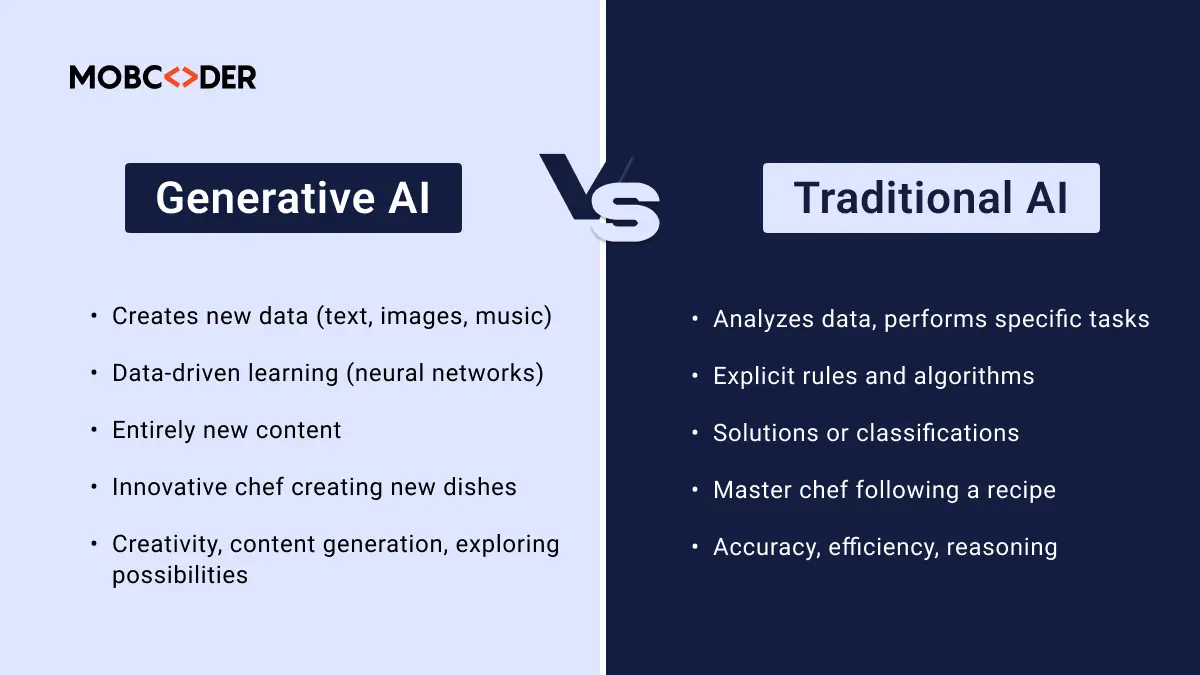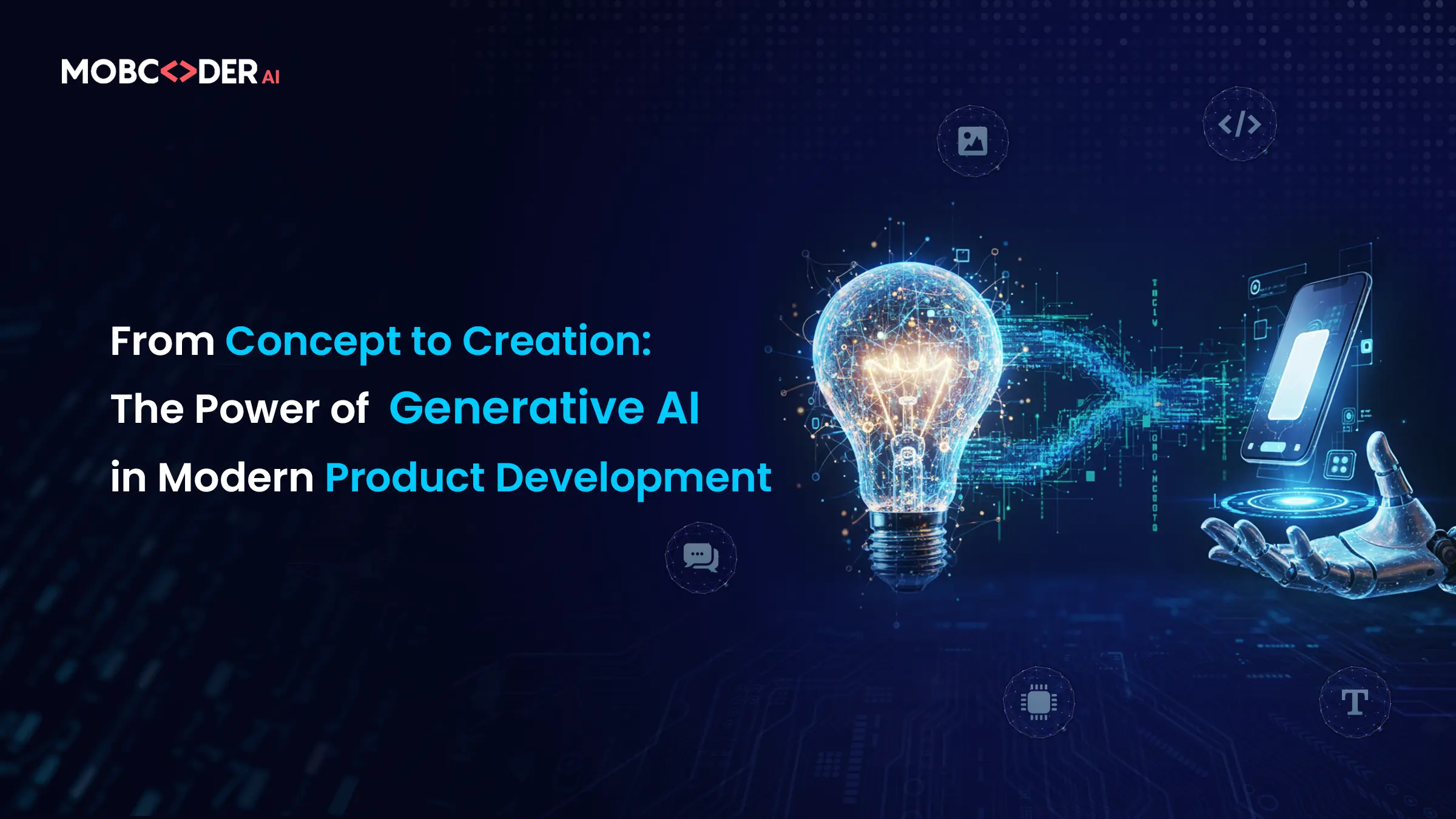May 16, 2025
Marc Rothmeyer
What Is Generative AI and Why It Matters
Why Generative AI Is Gaining Popularity
How Generative AI Is Used in the Real World
The Challenges and Limitations of Generative AI
The Future: Generative AI Meets Agentic AI
Mobcoder's Role in the Generative AI Journey
How to Get Started With Generative AI
The landscape of digital innovation is evolving rapidly, and at the heart of this transformation lies Generative AI. From content creation to design, coding to music, Generative AI is no longer a futuristic concept—it’s here, and it’s reshaping how businesses operate, communicate, and create. Unlike traditional AI, which focuses on analysis and automation, Generative AI takes a leap forward by generating brand-new content. This game-changing technology is helping startups, enterprises, and creators across industries unlock new possibilities and scale like never before.
At Mobcoder, we’ve seen firsthand how Generative AI is turning imagination into execution with unprecedented speed. Whether you're building an app, designing marketing campaigns, or creating personalized digital experiences, Generative AI acts as your creative co-pilot, transforming your vision into reality.
Also Read - RPA: Empowering Businesses with UiPath Chatbots and Intelligent Automation
Generative AI refers to a branch of artificial intelligence that can produce new, original outputs based on the data it has been trained on. These outputs can range from written content and images to music, videos, code, and more. Unlike traditional AI, which typically categorizes or recommends existing content, Generative AI models—like GPT-4, Midjourney, and DALL-E—can generate entirely new material that mimics human creativity. This distinction is significant because it turns AI into an active creator, not just a supportive tool.
By training on large datasets, these AI models learn language patterns, visual cues, or logical coding structures. When prompted, they can produce outputs almost indistinguishable from those created by humans. The ability to create high-quality content on demand is revolutionizing workflows across industries.
The rising interest in Generative AI is fueled by the real-world advantages it offers to businesses and individuals alike.
One of the most attractive benefits of Generative AI is its speed. What used to take hours—or even days—can now be done in seconds. Whether it's writing a blog post, drafting an email campaign, designing a landing page, or generating code for a new feature, Generative AI significantly reduces production time. This efficiency enables companies to scale faster, respond to market trends quickly, and free up human teams for more strategic work.
Today’s digital users expect personalization. Generative AI makes it possible to deliver custom content at scale without manual intervention. Brands can generate multiple versions of ad copy, email campaigns, or product descriptions tailored to different audiences or personas. By leveraging user behavior and preferences, AI-driven content becomes more relevant and engaging, improving conversion rates and customer satisfaction.
Hiring large teams of designers, writers, or developers can be expensive. Generative AI helps businesses lower costs by automating repetitive and time-consuming tasks. For instance, generating technical documentation, writing FAQs, or creating UI mockups can be done by AI with minimal human input. This means smaller teams can do more with less, making operations more agile and cost-efficient.
Creativity isn’t always consistent, and many professionals face mental blocks during the creation process. Generative AI serves as a creative catalyst by providing suggestions, variations, and even complete drafts to get the ball rolling. Writers can overcome creative blocks, designers can explore multiple layouts instantly, and developers can prototype faster. It’s like having a brainstorming partner that’s always ready with fresh ideas.

Also Read - ChatGPT vs DeepSeek: The Battle of Conversational AI Technologies
Generative AI isn’t just a concept; it’s already being implemented across diverse sectors:
Marketing teams are using Generative AI to craft blog articles, newsletters, ad copy, and social media posts. These tools help maintain brand consistency while producing large volumes of content tailored to different audiences. AI-generated content also improves SEO efficiency by rapidly generating keyword-rich articles, meta descriptions, and product reviews.
In the world of software development, AI tools like GitHub Copilot are helping developers by writing boilerplate code, suggesting logic flows, or even completing entire functions. Developers can also use Generative AI to generate test cases, documentation, or debug code—saving countless hours and improving code quality.
Designers now use Generative AI to automatically create layout options, suggest font pairings, or generate UI elements based on simple prompts. This speeds up the prototyping process and allows for rapid A/B testing. Designers spend less time on repetitive tasks and more time on creative strategy.
In the healthcare sector, Generative AI is used to summarize patient records, generate care instructions, and assist in medical documentation. It also plays a role in developing patient-facing content, helping to explain complex procedures in easy-to-understand language. In some cases, AI-driven virtual assistants can support patient queries 24/7.
Retailers and e-commerce platforms use Generative AI to create product descriptions, reviews, and visual assets. AI tools also help develop dynamic shopping experiences, personalized landing pages, and AR-powered product visuals that improve user engagement and drive sales.
Despite its potential, Generative AI isn’t without its challenges. One of the key issues is accuracy—AI-generated content isn’t always factually correct. It can hallucinate or generate biased responses based on the data it was trained on. Therefore, human oversight is essential to ensure outputs are reliable, accurate, and aligned with brand voice and values.
Additionally, legal and ethical concerns around content ownership and plagiarism are still evolving. Since these models are trained on publicly available data, it's difficult to track originality. Businesses must remain cautious when using AI-generated content for public-facing materials.
Also Read - How AI Has Changed Software Development Outsourcing: Revolutionizing Efficiency and Innovation
The next wave in AI is the emergence of agentic AI—intelligent agents that not only generate content but also take actions. For example, an AI tool might write an email, send it automatically, respond to replies, and update a CRM without human involvement. When combined with generative capabilities, these agents will change how businesses run marketing campaigns, customer service operations, and internal workflows.
This evolution will allow AI to become more than just a content assistant; it will become a digital teammate capable of understanding objectives, making decisions, and executing multi-step tasks autonomously.

At Mobcoder, we’re at the forefront of integrating Generative AI into product development, mobile app creation, and digital experience design. We use AI-powered tools to speed up wireframing, create marketing content, and build intelligent features into apps. Our team works closely with clients to ensure that AI complements human creativity rather than replacing it. By blending innovation with practicality, we help businesses of all sizes implement AI solutions that deliver real value.
Starting with Generative AI doesn’t require a large budget or technical team. The key is to identify a specific area—like content writing, development, or design—where AI can add value. Use tools like ChatGPT, Canva AI, or GitHub Copilot to experiment. Focus on prompt engineering, test different outputs, and learn how to iterate. Most importantly, don’t treat AI as a replacement—treat it as a smart assistant that amplifies your capabilities.
And if you're ready to go deeper, partner with an expert team like Mobcoder. We can help you embed AI into your digital infrastructure and take your product or brand to the next level.
Also Read - Why Explainable AI (XAI) is Crucial for Trust and Transparency in AI Systems
Generative AI is not just another tech trend—it’s a fundamental shift in how we work, create, and scale. It brings together creativity, intelligence, and automation in one powerful package. Whether you’re building an app, designing a brand, or launching a product, Generative AI gives you the tools to do more, faster, and better.
The only question is: Are you ready to create the future with AI?

Chris Chorney
October 29, 2025
6min

Marc Rothmeye
September 29, 2025
6min

Girijesh Kumar
September 04, 2025
6min